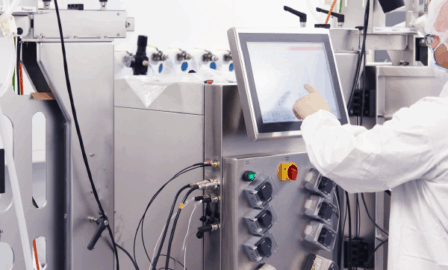Part 2: A Supply Chain Predictive Analytics Conversation
I had a recent opportunity to get Patrik Latin's perspective, as a senior pharmaceutical executive, on what predictive analytics means for the future of supply chain. I am so pleased to share his vision for with you through this blog series.
In this follow-up post in our predictive analytics series, we’ll discuss why supply chain predictive analytics are important for supply chain executives to incorporate into their modeling practices (Part 2). Stay tuned for the final post on how to get started incorporating these data elements into your process (Part 3).
Sebastian: What motivation do supply chain executives have to pay attention to predictive analytics? What’s in it for them? What are the key benefits to the supply chain in enacting a predictive analytics capability?
Patrik: In the past two decades, my experience has been that too often the supply chain function’s activities were reduced to just firefighting and extreme reactive behavior, often promoted by the executive teams due to a quarterly mindset. This ends up creating inefficiencies and imbalance between service, inventory, and costs, and even further down the line, negatively impacting long-term strategy. With predictive analytics, we are entering a new era whereby the supply chain function can proactively show potential bottlenecks arising, which brings S&OP discussions to a totally different level throughout the organization.
Sebastian: That’s a great perspective. We’ve seen with our clients that it can open up discussions related to capital investment, install capacity, partnerships for sourcing, risk analysis related to M&A, political unrest, and beyond. Let’s talk more about the organization as a whole. Outside of cutting cost and managing inventory, what are the benefits to using predictive analytics for the organization outside of direct benefits to supply chain operations?
Download our predictive analytics e-book
Patrik: Overall we are talking about better decision-making for the company. This can happen in many ways. On the one hand, you get faster predictability in changing patterns, which leads to better customer service. On the other hand, predictive analytics can help decide which demand scenario will be best to base the capacity and production on rather than just choosing the most efficient and productive production plans. At this point we have not fully explored the full potential yet, I am convinced of that.
Sebastian: Seasonality with something like flu vaccines comes to mind, since early measurements on trends and models don’t always suffice. With predictive analytics, you unleash what-if analysis on forecast scenarios, allowing trigger points that enact alternative plans. Then, you can go to S&OP with real data and less gut instinct. Extending this example beyond the four walls of the pharma company, we would ultimately have fewer shortages in markets that need vaccines the most. Going beyond the four walls of a company, how does this differentiate and help increase shareholder value?
Patrik: Overall, this is improving the decision making process in various disciplines, resulting in faster acting to changes, higher efficiencies and productivity, to even postponing capital expenditures, so the value increase is clear to me.
Sebastian: While we’re on the topic of upstream, what benefits to the patient would predictive analytics provide?
Patrik: For the patient, if we consider the most optimized situation, we experience full availability of the product range to the customer, and therefore the cost reductions can be calculated all the way up into price reductions for the patient. As for the pharmacies and hospitals, I would argue they enjoy the same benefits as the patient. Specifically though, they could expect greater fulfillment levels, lower inventory cost across the chain, and higher inventory turns, reducing cost of capital. Distributors experience all the same benefits we already mentioned. But there’s an additional benefit, as distributors are the ones working most closely with pharmaceutical companies. Predictive analytics can lead to a more desirable partnership approach by providing better cooperation and value-shared decision making.
Sebastian: Those are all very tangible benefits. One example that comes to mind is that when McKesson and CVS signed their purchasing agreements, pharmaceutical companies felt a sudden decline in demand abruptly. But we all should have been able to predict it. Both companies were holding too much inventory individually before the merger, so it shouldn’t have been a surprise. The data was there, and with predictive analytics it could had been avoided. Let’s shift to discussing downstream. How about the CMOs or the API manufacturers?
Patrik: Obviously what counts for upstream also works downstream. We have been facing way too many irregular demand patterns that lead to incredible short delivery lead-time requests. As a result, our CMO’s and other component manufacturers were driven into hectic behavior, which in turn drove our costs up. This classic example of the well-known bullwhip effect could be significantly improved when predictive analytics are applied correctly.
Sebastian: When we started using predictive analytics with CMOs or downstream with our own API manufacturers, it helped in creating long term transparency. But it was a double-edged sword. Because it gave a lot of visibility, it uncovered hidden facts – and where the water gets lower, the iceberg gets bigger.
Patrik: Exactly. And we can extend this globally to trends such as growing regulations and value-based care. Really, any trend can be brought into your predictive analytics, when done right of course, and will give you better decision making options. Ultimately, it will significantly increase speed of reaction time to outside influences.
Thank you again Patrik for providing your insights on what benefits supply chain predictive analytics can provide for the pharmaceutical industry. Stay tuned for our final post to learn how you can get started with predictive analytics at your company (Part 3).
Interested in learning more? Download Clarkston’s latest e-book, A Supply Chain Predictive Analytics Conversation
About the Authors
 Patrik Latin is an enthusiastic business executive with over 25 years of international leading experience in multi-national healthcare companies. Patrik is a proven leader with a specialization in the areas of management, supply chain, operations and strategic procurement. Patrik is passionate about innovation and transformation of an organization during this new digital era with IoT, big data, blockchain technology, predictive analytics to bring them to a new maturity level of excellence.
Patrik Latin is an enthusiastic business executive with over 25 years of international leading experience in multi-national healthcare companies. Patrik is a proven leader with a specialization in the areas of management, supply chain, operations and strategic procurement. Patrik is passionate about innovation and transformation of an organization during this new digital era with IoT, big data, blockchain technology, predictive analytics to bring them to a new maturity level of excellence.
 Sebastian Valencia, partner with Clarkston Consulting, is responsible for advising senior executives from international organizations. He has extensive experience in supply chain strategy and distribution redesign, outsourcing through third party logistic providers, mergers and acquisitions, vendor selection, pricing and negotiation of supply chain contracts, and distribution network optimization.
Sebastian Valencia, partner with Clarkston Consulting, is responsible for advising senior executives from international organizations. He has extensive experience in supply chain strategy and distribution redesign, outsourcing through third party logistic providers, mergers and acquisitions, vendor selection, pricing and negotiation of supply chain contracts, and distribution network optimization.



